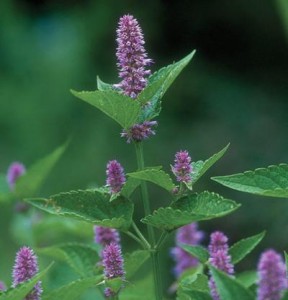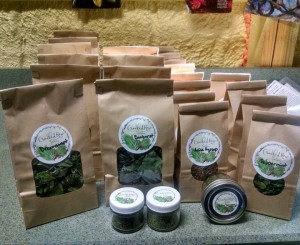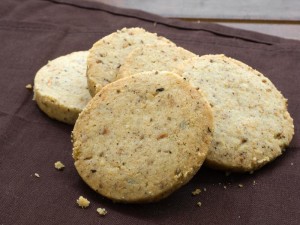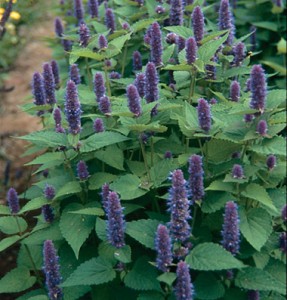By POP Intern, Lucia Kearney
Description
I first met anise hyssop one late summer day while helping my lovely friend Liz Wagner of Crooked Row Farm to finish up her CSA harvest so we could go grab milkshakes. Neither a member of the anise family nor the hyssop family, anise hyssop is actually a member of the Lamiaceae (mint) family. It grows between two and four feet tall, in a clump-like, upright shape. Bright lavender flowers bloom from June through September, and appear in verticillasters, which is a fancy name for flowers that grow in a false whorl. Like mint and catnip, anise hyssop has square stems. Leaves smell like anise, hence the name, and are ovular and broad in shape and dull green in color.

Liz had her anise hyssop planted in the last bed before the woods at the top of the hill, a good spot considering that these plants require well-draining soil, and are repugnant to deer. Anise hyssop is a perennial plant native to north-central and northern North America, including the Great Plains and parts of Canada; wild anise hyssop is most-often found in openings in dry upland forests, and the upland areas of prairies. In gardens, various cultivars are often planted around the edges, both as a way of attempting to repel deer, for the plant’s various herbal uses, and for its beautiful purple flowers. Anise hyssop is also a great pollinator, attracting bees, hummingbirds, and butterflies to the garden for months out of the year.
Here’s a video of Liz at the Blue Mountain Farmer’s Market in Slatington talking about anise hyssop:
http://www.mcall.com/features/food/mc-video-farm-fresh-anise-hyssop-20160629-premiumvideo.html
Uses
Anise hyssop has a long history of use. Leaves can be used as a seasoning, dried for use in tea, used fresh in salads, or made into jellies. As leaves maintain their scent well when dried, anise hyssop can also be used in potpourri. Flowers are edible and make a nice addition crumbled into a salad, or added to baked goods, such as these anise hyssop whoopee pies, or these butter cookies, pictured below. As usual, the Internet delivers with plenty of recipe ideas; you can check some out here.


Anise hyssop has long been used in traditional herbal medicine, especially amongst Native Americans. Infused in tea, anise hyssop can be used to relieve congestion, acting as an expectorant (clearing mucus from lungs and airways). A cold-infusion can be used to relieve chest pains caused by excessive coughing, and mixed with licorice, it can be used to treat respiratory infections and bronchitis. A hot infusion induces sweating, and can therefore be used to help with fevers; as a result of this quality, the Cheyenne were also said to use anise hyssop in sweat lodges.
Clinical research has shown anise hyssop essential oil to be antiviral towards Herpes simplex I and II. Used as a poultice, anise hyssop is said to help treat burns, and, made into a salve, can be used to treat wounds. The Iroquois were said to make a wash from it used to relieve the itching associated with poison ivy. Anise hyssop is also purported to have mood-lifting qualities, and it was burned in incense as a sort of anti-depressant by some Native American groups.

Propagation/Cultivation
As a native plant, anise hyssop is fairly hardy and disease free; plants are drought-resistant once established and deer-resistant. Anise hyssop prefers full or partial sun and fairly dry conditions. It can survive well in loam, clay-loam, and in soil that contains some rocky material. Soil should have good drainage to avoid root rot. Slugs and insects will occasionally feed on the leaves, but usually not to a significant degree.
Plants spread naturally by rhizomes, and will also self-seed if growing conditions are optimal; they can easily be propagated by transplanting self-sown seedlings or dividing clumps in the spring. Anise hyssop can also be started from seed indoors and transplanted later. Seeds can also be scattered outside in the fall. After hanging bundles to dry and packing them away, for example, it’s easy to toss the seeds left at the bottom of your bowl into your garden. As they would naturally, they will overwinter and then sprout in the springtime.
Whether you’re meeting for the first time, or are continuing life’s adventures with a long-time friend, brew up some tea, whip up a batch of cookies, and enjoy some quality time with good ol’ anise hyssop.
SUPPORT US! If you found this entry useful, informative, or inspiring, please consider a donation of any size to help POP in planting and supporting community orchards in Philadelphia: phillyorchards.org/donate.
Disclaimer
The Philadelphia Orchard Project stresses that you should not consume parts of any wild edible plants, herbs, weeds, trees, or bushes until you have verified with your health professional that they are safe for you. As with any new foods that you wish to try, it is best to introduce them slowly into your diet in small amounts.
The information presented on this website is for informational, reference, and educational purposes only and should not be interpreted as a substitute for diagnosis and treatment by a health care professional. Always consult a health care professional or medical doctor when suffering from any health ailment, disease, illness, or injury, or before attempting any traditional or folk remedies. Keep all plants away from children. As with any natural product, they can be toxic if misused.
To the best of our knowledge, the information contained herein is accurate and we have endeavored to provide sources for any borrowed material. Any testimonials on this web site are based on individual results and do not constitute a warranty of safety or guarantee that you will achieve the same results.
Neither the Philadelphia Orchard Project nor its employees, volunteers, or website contributors may be held liable or responsible for any allergy, illness, or injurious effect that any person or animal may suffer as a result of reliance on the information contained on this website nor as a result of the ingestion or use of any of the plants mentioned herein.
Sources
https://en.wikipedia.org/wiki/Agastache_foeniculum
http://www.illinoiswildflowers.info/prairie/plantx/anise_hyssopx.htm
http://www.finegardening.com/anise-hyssop-agastache-foeniculum
http://www.missouribotanicalgarden.org/PlantFinder/PlantFinderDetails.aspx?kempercode=d554
http://backyardpatch.blogspot.com/2013/08/anise-hyssop-herb-of-week.html
http://www.motherearthliving.com/plant-profile/anise-hyssop.aspx
http://www.sandmountainherbs.com/articles/Agastache-foeniculum-medicinal-uses.html
http://www.healthygreenkitchen.com/anise-hyssop.html
Pictures/Videos
- http://www.finegardening.com/anise-hyssop-agastache-foeniculum
- Video: http://www.mcall.com/features/food/mc-anise-hyssop-farmers-markets-20160705-story.html
- Photo Credit: Liz Wagner
- http://backyardpatch.blogspot.com/2013/08/anise-hyssop-herb-of-week.html
http://www.johnnyseeds.com/p-7978-anise-hyssop.aspx